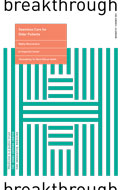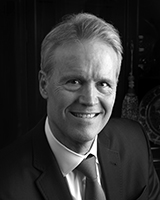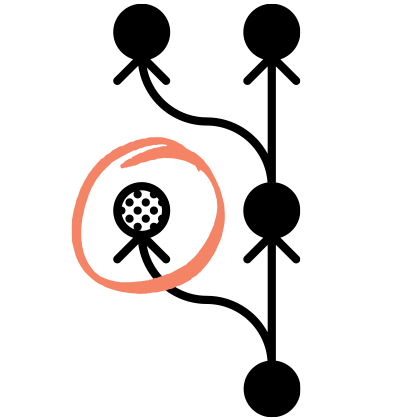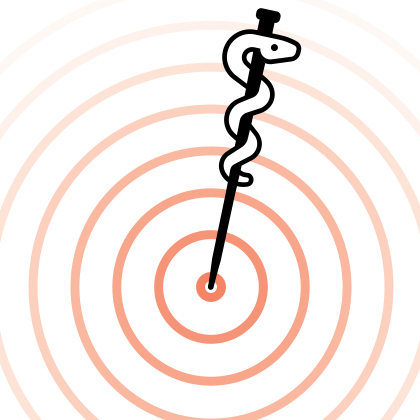

David B. Hellmann,
MD, MACP
Despite the many challenges in our world, we have much to celebrate and be grateful for, this spring of 2022. For starters, I am immensely appreciative to the loyal supporters of the Center for Innovative Medicine who have joined together to establish a professorship in my name, which will support CIM’s mission in perpetuity. What an honor! Typically, we would host a large event to celebrate the generosity of our donors who have made this momentous gift possible. While COVID-19 continues to restrict these plans for now, rest assured that we will indeed host a celebration as soon as safety allows. I should also note that this is the fourth named professorship for the CIM, and at last count, we can boast 47 funded CIM Scholars — a clear indication that CIM’s stock is on the rise.
Another indication of that “rising stock” is the enthusiasm we are seeing for CIM’s new Initiative to Humanize Medicine, our ambitious effort to unite researchers from disciplines and divisions across Johns Hopkins University in a far-reaching effort to better equip clinicians to get to know their patients as people. Already, the initiative is attracting significant support that I will describe more fully in the fall.
In similar fashion, the CIM-supported Human Aging Project (HAP) is flourishing, thanks to generous early support from donors including the Charles Salisbury Family, Sarah Miller Coulson, and Ethan and Karen Leder, who had the foresight to see the potential HAP holds to dramatically extend years of good health for our rapidly graying population. Seed funding from these and other donors has allowed our researchers to embark on projects that have subsequently garnered millions of dollars in grant funding from the National Institutes of Health and other funding agencies. Success begets success!
You’ll read about many of these CIM success stories in the pages that follow, and I hope that the tremendous promise all of this work holds — promise for humanizing medicine and advancing medicine as a public trust — will “fill your tank” with hope and excitement for the future.

David B. Hellmann, M.D., M.A.C.P.
Aliki Perroti Professorof Medicine
Don Willett May 16th, 2022
Posted In:

David B. Hellmann,
MD, MACP
Despite the many challenges in our world, we have much to celebrate and be grateful for, this spring of 2022. For starters, I am immensely appreciative to the loyal supporters of the Center for Innovative Medicine who have joined together to establish a professorship in my name, which will support CIM’s mission in perpetuity. What an honor! Typically, we would host a large event to celebrate the generosity of our donors who have made this momentous gift possible. While COVID-19 continues to restrict these plans for now, rest assured that we will indeed host a celebration as soon as safety allows. I should also note that this is the fourth named professorship for the CIM, and at last count, we can boast 47 funded CIM Scholars — a clear indication that CIM’s stock is on the rise.
Another indication of that “rising stock” is the enthusiasm we are seeing for CIM’s new Initiative to Humanize Medicine, our ambitious effort to unite researchers from disciplines and divisions across Johns Hopkins University in a far-reaching effort to better equip clinicians to get to know their patients as people. Already, the initiative is attracting significant support that I will describe more fully in the fall.
In similar fashion, the CIM-supported Human Aging Project (HAP) is flourishing, thanks to generous early support from donors including the Charles Salisbury Family, Sarah Miller Coulson, and Ethan and Karen Leder, who had the foresight to see the potential HAP holds to dramatically extend years of good health for our rapidly graying population. Seed funding from these and other donors has allowed our researchers to embark on projects that have subsequently garnered millions of dollars in grant funding from the National Institutes of Health and other funding agencies. Success begets success!
You’ll read about many of these CIM success stories in the pages that follow, and I hope that the tremendous promise all of this work holds — promise for humanizing medicine and advancing medicine as a public trust — will “fill your tank” with hope and excitement for the future.

David B. Hellmann, M.D., M.A.C.P.
Aliki Perroti Professorof Medicine
Don Willett May 16th, 2022
Posted In:

Early in her career, geriatrician Esther Oh noticed something alarming among her older patients.
“Family members would bring in their loved one and say, ‘Mom went into the hospital for a routine elective surgery and she was functioning normally. Now, after the surgery, she suddenly has problems with memory and needs our help. What happened?’”
Oh, who today is co-director of the Johns Hopkins Memory and Alzheimer’s Treatment Center, set out to investigate that question. She and others in the field ultimately landed on post-operative delirium as a culprit in this cognitive decline. This delirium, experienced by up to 50% of older adults who undergo surgery, is a state in which patients become agitated and confused, their perceptions and memory thrown off as they struggle to make sense of their world after surgery.
“We think that some older people can function normally by relying on a cognitive reserve. Then they go into the hospital and experience post-operative delirium, and this inflicts a hit to the brain, unmasking any underlying dementia process so that they can no longer compensate and they exhibit this acute decline,” says Oh, who was recently named Sarah Miller Coulson CIM Scholar.
The good news? In about 40% of patient cases, postoperative delirium can be prevented entirely, through careful teamwork of health care professionals, including physicians and nurses, as well as physical and occupational therapists. The interventions may range from close monitoring during surgery and anesthesia, to taking steps immediately after surgery to orient patients to their surroundings and get them up and moving as soon as safely possible. Oh is now leading a student/trainee “incubator” team, part of the CIM-supported Human Aging Project, to identify which patients are most at risk for developing post-operative delirium and to develop a sustainable model for prevention.
These efforts are just one part of an ambitious initiative now underway at Johns Hopkins Bayview Medical Center. The HAP initiative, created and led by Jeremy Walston, the Salisbury Family Foundation CIM Scholar, aims to transform the way health care is delivered to older adults by creating an “age-friendly” approach across the care spectrum — from the emergency department to primary care, from surgery to rehabilitation, from the memory center to home health care.
“Older people, many of whom are coping with multiple chronic health conditions, experience the bumps and challenges of our health care system in this country because it is so siloed,” says Cynthia Boyd, director of the Division of Geriatric Medicine and Gerontology. “At Bayview, we are part of a national initiative to break down those silos — to create a more seamless experience for older patients and make it much easier for them and their caregivers to navigate to get the care they need.
“It really is a paradigm shift,” says Boyd, the CIM Lavinia Currier Scholar.
As laid out by the Institute for Healthcare Improvement, the framework for an age-friendly health care system consists of “4Ms” that are aimed at making complex care more manageable:
Medication: Ensuring that patients are properly taking only the medications they need and avoiding potentially harmful drug reactions that can occur if communication between health care providers breaks down
Mentation: Providing a united effort to prevent, identify and treat anxiety, depression and delirium
Mobility: Ensuring that older adults move safely, avoiding falls, to maintain function
What Matters Most: Knowing and aligning care with each individual’s specific health outcome goals and care preferences, including end-of-life care
Boyd also adds a fifth “M” to the age-friendly initiative at Bayview: multi-complexity. “It’s so important for us as health care providers to see the whole person — as a unique individual with unique psychosocial needs.”
“At Bayview, we are part of a national initiative to break down those silos — to create a more seamless experience for older patients and make it much easier for them and their caregivers to navigate to get the care they need.” — Cynthia Boyd
She emphasizes that it’s not just the Division of Geriatric Medicine and Gerontology that is committed to this model. “There’s a real synergy across Bayview,” she says. “The Emergency Medicine Department was recently accredited as a geriatric ED, for example, and we have great partnerships with the Memory Center, the Johns Hopkins Bayview Medical Center leadership and the Department of Surgery, among other areas.”
Colorectal surgeon Susan Gearhart is an enthusiastic partner and has been leading efforts over the past few years to establish geriatric surgery pathways at Bayview — standards of care aimed at helping older patients get through surgery safely and to avoid unwanted outcomes, such as loss of independence.
Her team has zeroed in on preventing post-operative delirium by providing more individualized care. “Historically, most ‘standards of care’ were one size fits all,” says Gearhart. “Now these standards are becoming more personalized.”
For example, anesthesiologists are administering anesthesia to the level of sedation the individual patient actually needs, rather than to a standardized level. And to avoid dehydration, which can contribute to delirium, some patients are now allowed to have water right up until surgery.
“And we’re reducing the use of narcotics for pain control after surgery to provide just the amount that patient needs,” says Gearhart.
She notes that the nurses in the post-anesthesia care unit (PACU) are crucial to providing each older patient what they need to return to a normal state as soon as possible, largely by following the 4M’s. “They start from the minute the patient gets out of surgery to get them on a pathway home,” she says.
Gearhart elaborates: “Traditionally, patients in the PACU would be kept in bed on pain medications. Now our nurses turn down their fluids and get them out of bed as soon as possible, safely reducing the use of tethers like oxygen. Nurses also return patients’ glasses and hearing aids immediately, encouraging interactions with family members — and a return to normal sleep/wake cycles by turning off the TV and lights at night — to help patients get re- oriented as quickly as possible.”
Reducing hospital length of stay and improving outcomes require a high degree of communication and collaboration between all the members of the care team. Toward that end, Gearhart says, team members last year launched a weekly Zoom on Friday mornings to better prepare for patients coming in for surgery the following week. These meetings include nurse managers, as well as staffers from social work, the chaplains office, anesthesiology, geriatrics and other departments.
“We talk about our sickest, frailest patients and the steps we can take to provide the most effective care, such as placing them in rooms closest to the nursing station,” says Gearhart.
“Taken together, all of these steps are allowing our nurses to take care of their patients the way they’ve always wanted to take care of them.”
Geriatrician Michele Bellantoni, clinical director, Division of Geriatric Medicine and Gerontology, believes that the Bayview campus — with its robust array of programs, clinics and centers already in place to address the health needs of older patients — offers the ideal spot for establishing a seamless, age-friendly approach to health care.
“By coming together to collaborate on this initiative,” she says, “we will improve the lives of our older patients and teach the next generation of health care providers how to provide the very best care for older adults.”
Don Willett May 16th, 2022
Posted In:

Many of us learned in high school biology about the “mighty mitochondria” — the powerhouse of the cell that turns energy from food into energy that the cell can use.
But what you may not know, explains Hopkins cell biologist Hiromi Sesaki, is that every one of our cells is actually packed with hundreds of mitochondria, all toiling away to give our heart and brain and lungs the energy they need to function effectively. To do that work, the mitochondria are constantly dividing.
“This division is very dynamic — it’s happening all the time, and it’s a crucial process because it serves as a type of ‘quality control’ within the cell by removing damaged mitochondrial DNA that accumulates,” explains Sesaki, a newly named Karen and Ethan Leder CIM Human Aging Project (HAP) Scholar.
This damage removal process is known as mitophagy. And as we age, our mitochondria become less adept at mitophagy — at removing the “trash” (DNA mutations and deletions) and other toxins that accumulate in our cells.
Thanks to his new Leder Scholar funding, Sesaki and his lab are zeroing in on the biology of the mitophagy process. “We hypothesize that decreased mitophagy contributes to reduced mitochondrial health during aging, leading to neurodegenerative diseases such as Parkinson’s disease and Alzheimer’s,” he says.
But there’s a bright side, he notes: “We also think that enhancing the mitophagy process could allow us to slow — or even reverse — some of the ravages of human aging.”
Their research has two parts. In the first part, Sesaki and his team are developing a mouse model that has been genetically engineered (through a high-tech process known as CRISPR) to allow the scientists to stimulate mitochondrial division. These genetically engineered mice, dubbed eMitophagy mice, “will allow us to examine the specific impact of enhanced mitophagy on aging at the whole organism level. Specifically,” he says, “we’ll be looking at the brain and heart — two major organs that are affected by aging and that have a high demand for mitochondrial energy.”
“We hypothesize that decreased mitophagy contributes to reduced mitochondrial health during aging, leading to neurodegenerative diseases such as Parkinson’s disease and Alzheimer’s.” — Hiromi Sesaki
In part two of the project, the scientists will focus on real human cells, from people ages 2 to 96, obtained through a biobank repository. The researchers will use live-cell imaging to compare mitophagy activity between young and old cells. Then they will test to see whether enhancing the mitophagy process can improve mitochondrial health in cells of people of all ages.
Ultimately, says Sesaki, the outcomes of both avenues of study could provide fundamental evidence that enhanced mitophagy has potential clinical benefits against aging-associated changes in mitochondrial health, as well as brain and heart function in mice and human cells.
“This could have a transformative impact,” he says, “allowing for the future development of drugs that could target cellular mitophagy to improve the quality of life during aging — and therapeutic interventions for diseases like Parkinson’s and Alzheimer’s.”
It’s worth noting that until Sesaki received the Leder Scholar funding, he had not worked directly on the problems of aging. It was the call for proposals from Jeremy Walston, Human Aging Project director and the Salisbury Family CIM Scholar, that got Sesaki thinking about how his investigations into mitochondrial biology could have implications for aging biology.
“The Leder Scholar funding has given me and my lab an excellent opportunity to move into the area of aging research, and I expect multiple new collaborations with HAP investigators to emerge,” says Sesaki. He adds, “I plan to apply for an R01 from the National Institute on Aging during the term of my Leder grant, and I’m confident that this support from the Human Aging Project will enable us to obtain exciting data to be competitive in that grant application.”
Don Willett May 16th, 2022
Posted In:

In her 35 years serving on the faculty and as an administrative leader for the Johns Hopkins University School of Medicine, Cynthia Rand has adeptly led some of the institution’s most important initiatives — from co-directing the Aliki Initiative (with Roy Ziegelstein), to laying the groundwork for the new school of medicine clinical excellence faculty promotion track, to guiding key mentoring efforts for junior faculty, to establishing the Academy at Johns Hopkins for retired faculty members.
“I often refer to Cindy as the smartest person in the room, and she has tapped into that wisdom to lead critical change efforts here at Johns Hopkins,” says CIM Director David Hellmann. “Quietly and without fanfare, she has left her fingerprints on so many important areas.”
Most recently, Rand has stepped up to co-lead the CIM’s new Initiative to Humanize Medicine, together with internist Mary Catherine Beach. The ambitious new initiative will unite researchers from disciplines and divisions across Johns Hopkins University in a far-reaching and systematic effort to better equip clinicians to get to know their patients as individuals.
We sat down recently with Rand, senior associate dean for faculty at the school of medicine, and asked her to reflect on some of the highlights of her far-reaching and impactful career at Johns Hopkins.
You’ve received a number of notable awards for mentoring. Why is mentoring so important to you — and to Johns Hopkins as an organization?
Academic medicine is a very challenging environment in which to build a career. And it’s crucial to junior faculty coming up through the ranks to have a cheerleader. I can’t tell you how many times a young faculty member I am mentoring quietly shares with me that they feel like an imposter — that they’re nowhere near as good as their colleagues. I can assure them that they’re not alone, that about 700 of their peers feel exactly the same way.
Having the sponsorship of a more senior faculty member is hugely important for younger faculty to advance, for building bridges and opening doors. For those of us who have been around Johns Hopkins forever, we know the landscape and where the opportunities lie. So, if in a casual conversation, a young faculty member mentions a promising idea or area of interest, it’s very easy for me to send an email to connect them to someone doing work in that area. These types of connections are crucial for moving their careers forward.
Is mentoring particularly important for those who haven’t traditionally had strong representation in leadership, such as women and those in groups under-represented in medicine?
Yes, for sure. My first significant leadership role was chairing the Department of Medicine Women’s Task Force, which I had joined early in my Hopkins career because of my passion for advancing the careers of women in medicine. At that time, it was rare to have women in positions of leadership, and faculty of color were virtually non-existent as leaders. That was such a great loss to the organization — to have such a singularly white, male perspective guiding everything.
Over time, Johns Hopkins has made a commitment to hiring and advancing the careers of more diverse faculty members — though, of course, there remains room for improvement. This has led to new, richer perspectives across the organization and created a much better environment for mentoring for women and those under-represented in medicine. They can look around now and see a community of leaders who look like them — who provide living examples of how to advance in academic medicine.
“Having the sponsorship of a more senior faculty member is hugely important for younger faculty to advance, for building bridges and opening doors.” — Cynthia Rand
Last fall, you were honored with the second annual Award for the Support of Clinical Excellence at the Miller Coulson Excellence in Patient Care Symposium, for guiding implementation of the new clinical excellence promotion track for faculty. How is the promotions track the culmination of years of work by you and others?
The groundwork for defining and quantifying clinical excellence was laid when the Center for Innovative Medicine established the Miller Coulson Academy of Clinical Excellence in 2008. Until the Miller Coulson Academy, there was general skepticism that clinical excellence could be measured in a clear and consistent way. By developing a truly rigorous process for measuring excellence in clinical care, CIM really made a mark — at Johns Hopkins and on the national level.
As the Miller Coulson Academy advanced, we were able to use its groundbreaking work as part of our rationale in our presentation to school of medicine leaders that yes, we do know how to measure clinical excellence fairly and to create a rigorous promotional pathway. Without the Miller Coulson Academy, we never would have been able to successfully make that argument.
What does the new faculty promotion track mean for Johns Hopkins Medicine?
For the first time in 125 years, we can put a point of emphasis on the patient care aspect of our tripartite mission. Outstanding faculty members who are passionate about providing the best of the best in patient care can now be recognized with a clear career path forward. The new track will make it possible to recruit and retain the nation’s top clinicians. It’s going to make us immensely better as an institution.
Your efforts were key to establishing a community for retired faculty members as a way of supporting their continued research, teaching and service. The Academy at Johns Hopkins, East Baltimore Campus is now thriving, with 140 active members. What inspired your efforts?
This project is very close to my heart, and the inspiration came years ago when I had a conversation with a revered member of the faculty who had just retired. He said it felt like he had been pushed off a cliff. He had been an influential leader for 40 years and suddenly, he was irrelevant. I thought: There has to be a way to keep long-time faculty connected after they retire — with each other and with Johns Hopkins — and to tap into their wisdom and experience to benefit students, patients and Johns Hopkins, through teaching and mentoring.
The Academy at Johns Hopkins does just that. The retirees who participate have intellectual stamina; they are still gung-ho about their medical or scientific discipline and about engaging with their community. Why in the world wouldn’t we want to harness that brain trust — of people who love Johns Hopkins and care about making a difference in the world?
“For the first time in 125 years, we can put a point of emphasis on the patient care aspect of our tripartite mission.”
Could we conclude by briefly discussing your work with “pyramid grants” at Johns Hopkins Bayview — and how this approach will be wrapped into CIM’s new Initiative to Humanize Medicine?
The idea behind the pyramid grants is straightforward: Twice a year, we encouraged staff and faculty members to come up with inexpensive ways they could improve life for their patients and then submit a simple proposal for funding. This was open to everyone on the care team: doctors, nurses, techs, custodians. The novelty was that it was a totally grassroots idea with no bureaucracy involved. Each year, we funded six to seven projects, with funding ranging from $200 to $2,000.
Some were simple: I’d like a blanket warmer for my patients. Or: We need a basket of books and toys in our waiting room to keep kids occupied while their parents get treatment. One of my favorite proposals came from some staff in the chronic ventilator unit who wanted to improve the experience for patients on ventilators. They used their funds to install panels of peaceful scenes on the ceiling.
This is a wonderful example of humanizing medicine. Of asking people who deal directly with patients to identify ways to improve those patients’ lives — and then to give those caregivers the autonomy and resources they need to make that change. We’re planning to start a similar pyramid grant approach across Bayview and Johns Hopkins Hospital as part of the CIM’s Initiative to Humanize Medicine.
Don Willett May 16th, 2022
Posted In: